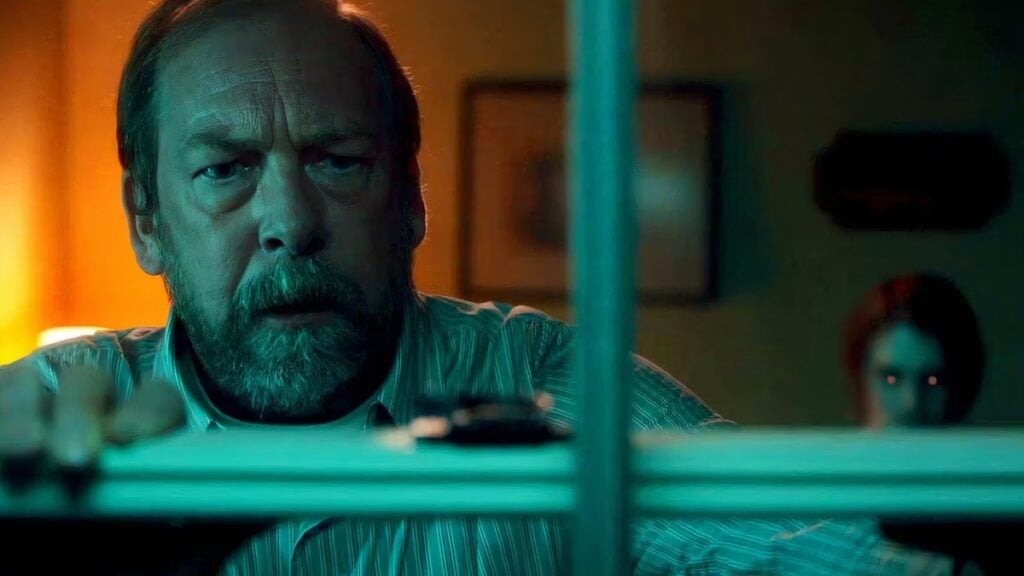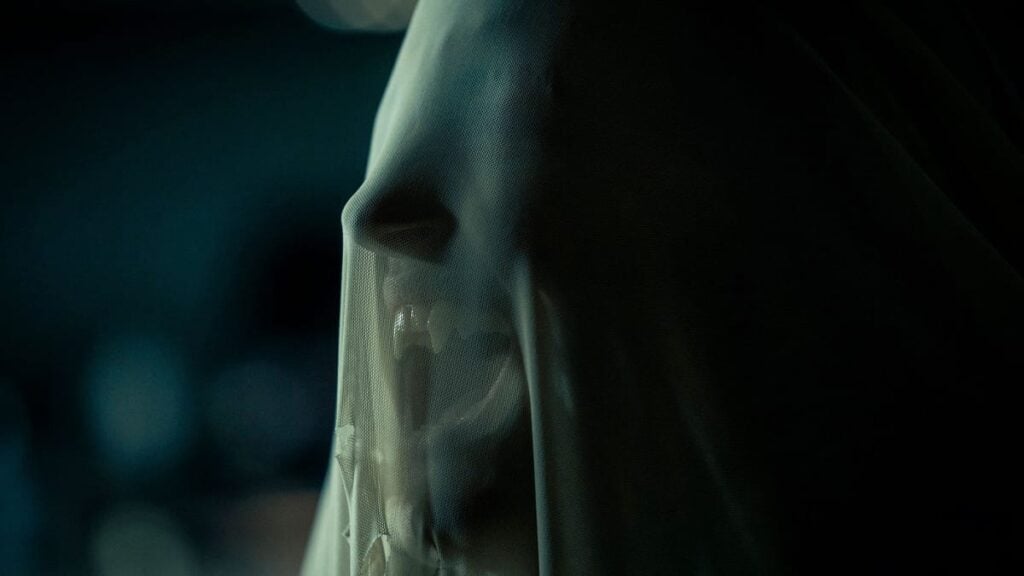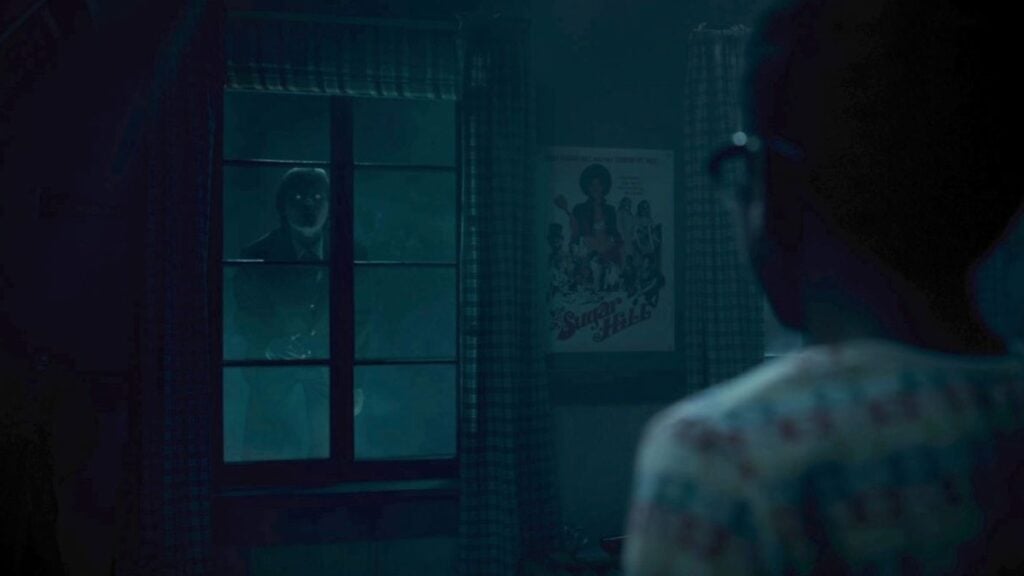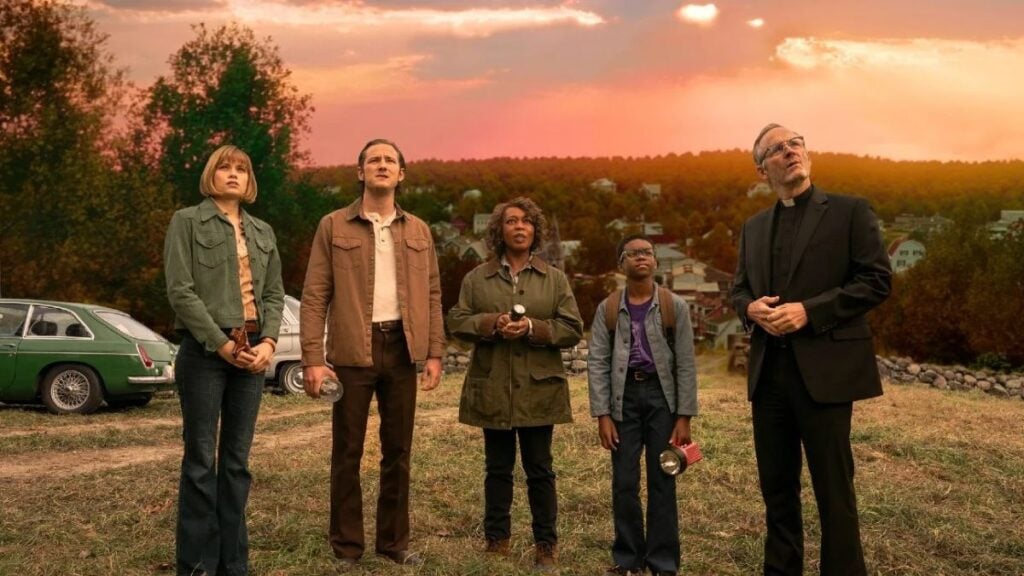Skip To...
Salem’s Lot doesn’t do much to update its 49-year-old source material. Instead, the straight-to-streaming adaptation revels in the outdated glory of small-town America. In that excitement, director Gary Dauberman seeks to bond with the audience over a love of old-fashioned drive-in movies. The result has some charm, but its bizarre pace, questionable character development, and milquetoast scares make the vampire film feel toothless.
Gary Dauberman gained more attention for his writing than his directing. He contributed scripts for the three Annabelle movies and The Nun. His directorial debut was 2019’s Annabelle Comes Home, which landed about as well as the other creepy doll movies. This is his second project as director, though it sat on a shelf for just over two years. The experience that probably got him this gig was his work on the recent It movies, which certainly come to mind during Salem’s Lot.
A Bad Time for Small Towns

The basic plot of Salem’s Lot remains more or less unchanged from the 1975 novel. Fans of Stephen King’s work will recognize it as one of his foundational texts. So many of his hallmarks are present, from the main character being an author to the setting in coastal Maine. Lewis Pullman, of Top Gun: Maverick fame, portrays the aforementioned writer, Ben Mears. He returns to his one-time home, the aforementioned Maine town of Jerusalem’s Lot, to research his next novel and his tragic backstory. Through Makenzie Leigh’s Susan, he sees a picture of an aging village that seems to trap its citizens. The locals are intensely suspicious of outsiders, especially when a young boy disappears without a trace. That missing kid quickly proves to be the first of many, and as the town’s population dwindles, something sinister emerges from Salem’s Lot.
The film isn’t really hiding its big reveal, especially since most people will know it before the opening credits give it away. Even if you’ve never read the 1975 novel or watched Tobe Hooper’s solid 1979 miniseries adaptation, you probably know that it’s about vampires. The characters aren’t so lucky, forcing them to slowly piece together the mystery. This process has a few stops and starts. Alongside Ben and Susan, relative newcomer Jordan Preston Carter appears as a fearless 11-year-old named Mark. The ragtag bunch also includes the great Alfre Woodard as a no-nonsense doctor and Bill Camp as the cool local middle school teacher. They’re a decent team, if a bit unbalanced. Mark is so comically competent that it begins to feel like the movie only doesn’t focus on him because it would be over in half an hour that way. The kid’s a natural vampire hunter.
Scares and Style

Salem’s Lot isn’t especially scary, which is a pretty significant problem. It relies mostly on jump scares and sudden screams. There are a couple of moments of engaging imagery that rely on unique lighting and color timing tricks, but they’re the exception to the rule. You never feel much tension, even when a vampire is breathing down someone’s neck. It almost slips into a more action-horror mode by the third act, evoking a zombie movie or maybe 30 Days of Night. The vampires oscillate between predatory animals and a cogent hive mind. They mostly leap out from shadows, grabbing people with all the grace of haunted house actors. Their kills are often bloody, but never particularly gruesome. That’s not to say that the film would particularly benefit from a few Friday the 13th slaughter scenes, but it feels as if it’s somewhere between 70s slashers and modern “elevated” horror.
The element of this film that surprised me the most was its stylistic vision. There are a couple of really striking shots that feel entirely out of place with most of the film. Early on, before the horror really sets in, two kids walk through the woods with a big, bold, beautiful blue and pink sky painting the backdrop. It looks like something out of an outsider animated movie. The first horror scene features a brief blast of bright red lights over a dangerous environment, slowly revealed to be the brake lights of a moving truck. So much of the world has this distinct orange tint, as if the movie needs to visually root you in something inherently old-fashioned. These color choices make Salem’s Lot stand out visually. Still shots from the film look somehow unique. I really appreciated these details, and it’s almost enough to recommend.
The Town is Dead

When Stephen King wrote Salem’s Lot, part of the appeal was the depiction of an American small town as a dying organism. The vampires are, in many ways, a personification of the rot that corrupts these once-great symbols of the nation’s wholesome lifestyle. They’re a virus that could only infect and overpower the organism once it became weak enough to succumb. Tobe Hooper’s adaptation captured the same introspective fear, depicting nostalgia and fear as King did four years earlier. Dauberman’s Salem’s Lot tries to reach for the same thematic depth, but it just doesn’t have the time to play with it. There are a few compelling visuals, but it doesn’t feel as focused as it should. It wants to sell a picture of a dying small town and a rollicking horror rush that would play on its drive-in theater screen, but it falls just short of both.
Salem’s Lot is fun enough to justify watching but familiar enough to justify skipping. I wanted to like it so much more than I did, but I simply can’t find a single thing it does exceptionally well. If it leaned a little more into any of its myriad directions, it might have found something a little more compelling. The small town is dying but horror cinema is still very much alive. Visit Salem’s Lot if you’re running out of other vampire movies, but don’t expect it to break any new ground.
'Salem's Lot
Salem's Lot is visually compelling, but the lack of scares, rough pacing, and muddled themes keep it close to its grave.
Pros
- Compelling visuals
- Solid performances
- Interesting lighting choices
Cons
- Lackluster scares
- Weird pacing
- Half-hearted themes







